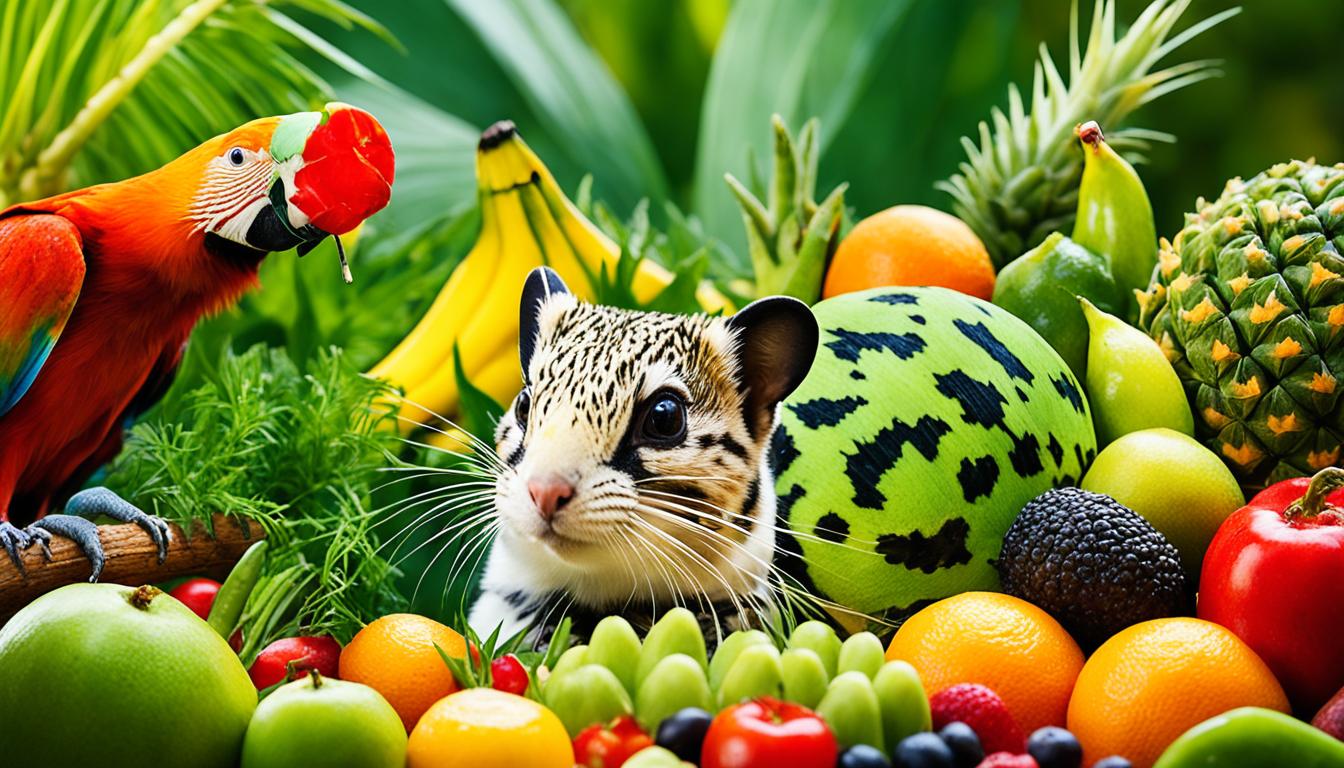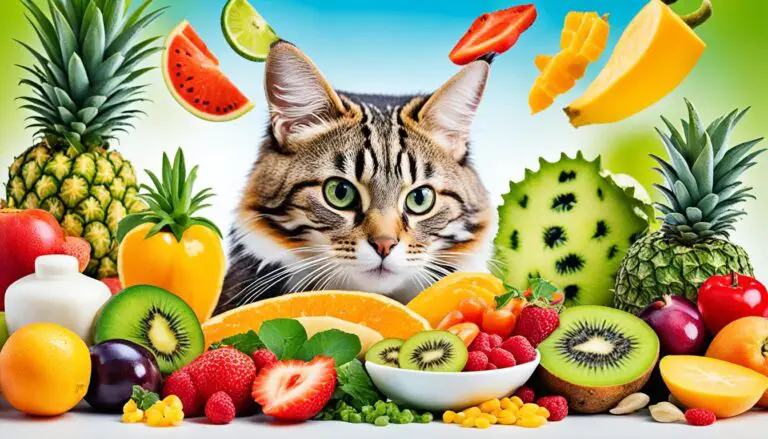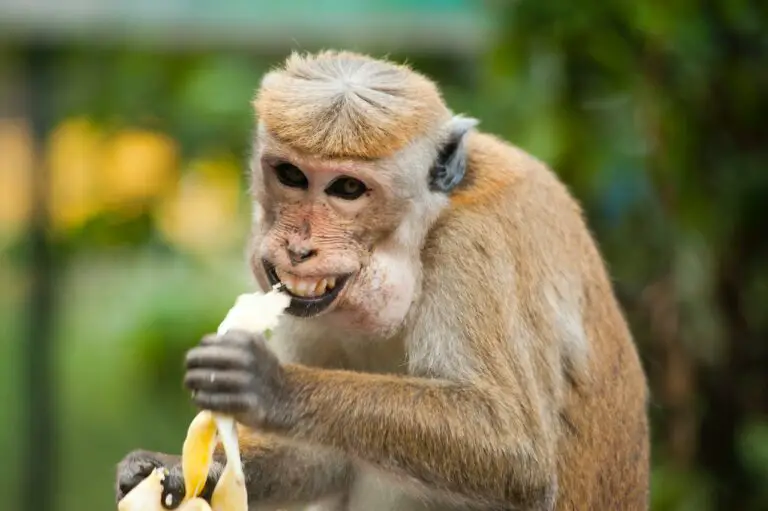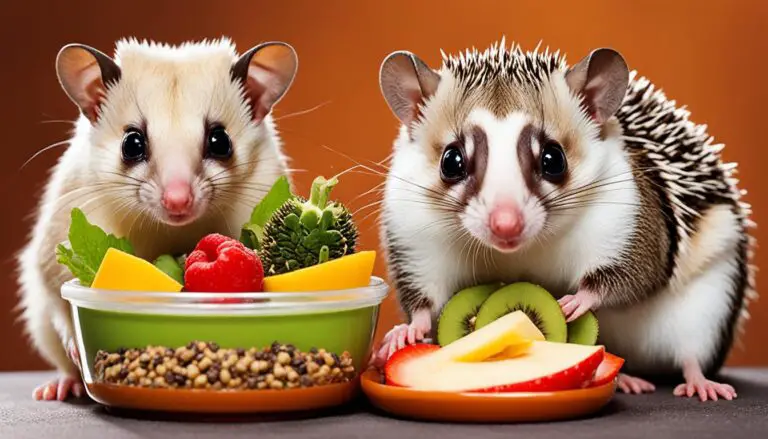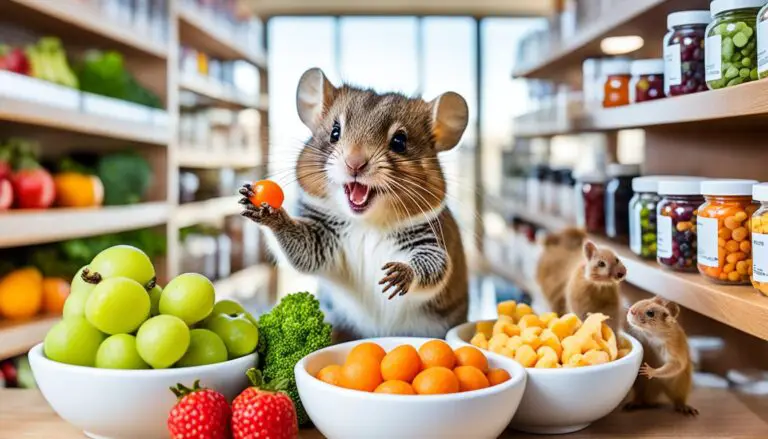Foraging Enrichment in Exotic Pets’ Natural Diet
Did you know that adding foraging to exotic pets’ diets can make them much happier? It lets them do what they’d naturally do in the wild. This can really spice up their lives.
Pets like parrots, waterfowl, chickens, rodents, and reptiles have special foraging needs. You can meet these by hiding food for parrots or scattering feed for ducks and chickens. It’s a fun way to keep them busy and sharp.
This article checks out the value of foraging time and its difference in the wild and at home. It talks about what’s best for various pet species. Plus, it gives lots of cool foraging ideas for exotic pets. We also cover the good stuff this can do and how to make it part of your daily life with pets.
Key Takeaways:
- Adding foraging to exotic pets’ diets makes them healthier and happier.
- It mimics their natural eating ways for a more fun and interesting life.
- Foraging can fit various pet needs, keeping them sharp and busy.
- It’s great for mental and physical health and stops boredom-induced bad behaviors.
- Adding foraging to daily routines is key for all-round pet welfare.
The Importance of Foraging Time
Foraging is key for animals in the wild. They spend a lot of the day looking for food and water. This helps them get the nutrients they need to live well.
The Optimal Foraging Theory looks at how animals decide where to find food. It helps scientists see how animals pick the best ways to eat. Studying how animals forage deepens our knowledge of nature’s balance and the struggle to survive.
“In the wild, animals face various challenges and constraints when foraging for food. They need to navigate, search for food, and deal with competition. Foraging is really important in their daily lives.”
Captive animals don’t have the same freedom to forage like wild animals. Yet, giving them the chance to seek out their food is essential. It helps these animals be mentally and physically well.
Creating foraging games for captive animals stops them from getting bored. It also boosts their health and makes them feel more at home. This can even reduce certain bad behaviors.
Foraging games not only fight boredom but also improve captive animals’ lives. They help the animals feel happier and healthier by letting them do what comes naturally.

Foraging Time Comparison between Wild and Captive Animals
| Wild Animals | Captive Animals | |
|---|---|---|
| Foraging Time | Significant amount of time spent foraging | May be limited without enrichment activities |
| Optimal Foraging Strategy | Optimize energy intake through efficient foraging | May not have the same optimization potential |
| Behavioral Benefits | Stimulates natural instincts and reduces boredom | Promotes mental and physical stimulation |
| Welfare Improvement | Enhanced overall welfare and satisfaction | Reduces the occurrence of behavioral issues |
Foraging in the Wild Vs Captivity
In the wild, animals often spend much of their time hunting for food. This experience is different in captivity. To keep captive animals healthy and happy, we should let them “search” for their food. This way they stay active and feel more like they do in the wild. By using methods that make finding food fun, we can make sure they stay interested and engaged.
Looking for food is a natural and important part of an animal’s life. Even if they’re not hunting, giving them challenges for their meals is good. It keeps them sharp and makes them feel satisfied.
“Foraging in the wild is essential for an animal’s well-being, both physically and mentally. Animals need to work for their food out there. This means they get exercise and keep their brains active. In captivity, their meals are often handed to them. This can make life less interesting. But, we can give them fun tasks to find their food. This helps them feel closer to the wild and improves their happiness.”
Foraging in the Wild
Out in nature, finding food is how animals survive. They have to use their senses and intelligence to eat. This searching is not just about food. It’s about doing what comes naturally, like climbing or running. For wild animals, finding meals is a way to stay healthy and happy.
Foraging in Captivity
It’s harder for animals to forage when they’re kept in zoos or sanctuaries. But, it’s up to us to help them. We can make their mealtimes fun by hiding food or using puzzles. This keeps them moving and thinking, just like they would in the wild.
Since they don’t have to find food in the same way, we have to make it interesting. Adding challenges and activities to their day keeps them sharp and satisfied. This kind of play is really important for their well-being.

Contrafreeloading
Contrafreeloading is an important term for captive animals. It means they like to work for food, even if it’s easy to get. By giving them things to do, like puzzles or hiding food, we keep them busy. This is great for their body and mind. It makes their life full and interesting.
| Foraging in the Wild | Foraging in Captivity |
|---|---|
| Occurs naturally as part of an animal’s daily life | Needs to be replicated in order to provide enrichment |
| Requires physical exertion and mental problem-solving | Can promote physical and mental exercise in captive animals |
| Stimulates natural behaviors | Provides a sense of fulfillment and satisfaction |
Foraging in Different Species
Foraging can match the needs of many species. Knowing how parrots, waterfowl, chickens, and more naturally forage helps. We can make the right foraging activities for them.
Foraging in Parrots
Parrots love to forage and explore. To keep them busy and healthy, hide their food. Put it in safe containers or use special boxes. This makes them work for their meals, like they would in the wild.
Foraging in Waterfowl and Chickens
Waterfowl and chickens can also enjoy foraging. Hide food like mealworms or scatter feed for them to find. This makes them think and stay active as they hunt for food.
Foraging in Pet Rodents
Hamsters and mice like to chew and explore. Wrapping treats in paper gives them something to play with. Creating obstacle courses for them adds fun and keeps them active.
Foraging in Reptiles
Even reptiles benefit from foraging. Tortoises, for example, can eat from hanging vegetation. Bearded dragons, eating insects, like to dig in plant piles. These activities copy their hunting process and offer good exercise.
Tailored foraging helps all exotic pets stay engaged and happy. It highlights their natural behaviors.

Importance of Metrics in Foraging Enrichment
It’s vital to measure the success of foraging activities for exotic pets. This approach is key to their well-being. Through data analysis, we can be certain that these activities meet their goals. Plus, we can advance the animals’ welfare over time.
The Metrics
Several critical metrics are involved in foraging enrichment evaluation:
- Foraging Time: This metric tells us how much time animals spend looking for food. It shows their excitement and interest in these activities.
- Amount of Free Food Offered: It’s about the amount of food given for foraging. This helps us know if we’re giving them enough to eat. We can adjust this if needed.
- Enrichment Effectiveness: It looks at how foraging affects the animals. This metric is vital to see if the enrichment helps them mentally and physically.
- Tracking Progress: This is about recording daily data and spotting trends. It helps us understand if the program is working and make needed changes.
By keeping an eye on these metrics, we can understand the animals better. This way, we ensure foraging is truly beneficial for them.
The Benefits of Tracking Metrics
Tracking metrics offers many advantages for foraging enrichment:
“Measuring foraging time, food amounts, and the effect of the program is key. It lets us fine-tune the program for each animal’s specific needs.”
- Optimizing Enrichment Activities: Data analysis helps us improve foraging activities. This ensures animals are always interested and stimulated.
- Personalized Enrichment: Metrics help us personalize foraging programs for each animal. We design it around what they enjoy and can do.
- Evidence-Based Adjustments: Using data, we can make smart changes in the program. This guarantees the animals have fun and learn through their experiences.
- Monitoring Overall Welfare: Tracking metrics keeps us alert to the animals’ general well-being. It prompts us to step in if they need help.
In short, tracking metrics is essential for making foraging activities great for exotic pets. It boosts their health, happiness, and life quality.
![]()
Foraging Enrichment Ideas for Exotic Pets
It’s important to keep exotic pets entertained and active. Foraging helps them stay engaged and happy. Here are some fun foraging ideas for your unusual pets:
For Parrots: Hiding Food in Bird-Safe Containers or Using Foraging Boxes
Parrots are smart and love to figure things out. You can hide treats in safe containers or use foraging boxes. They will enjoy looking for their food, and it keeps their minds sharp.
For Waterfowl and Chickens: Hiding Mealworms or Scattering Feed
Like in the wild, waterfowl and chickens enjoy searching for their food. Hide mealworms or scatter feed to promote their natural behavior. This keeps them happy and busy.
For Pet Rodents: Chewing Dry Treats and Navigating Obstacle Courses
Hamsters and rats love to chew and explore. Hide dry treats and use safe materials to set up obstacle courses. This entertains them and acts like their natural foraging habits.
For Reptiles: Hanging Vegetation or Digging Through Piles of Vegetation
Reptiles also benefit from foraging. Hang leafy greens for some and create digging spots for others. It mimics their wild habits and keeps them active.
“Pets thrive when they can engage in natural behaviors through foraging activities.”
Providing these activities is good for mental stimulation and well-being. Keep your exotic pets happy with these foraging ideas.
Foraging Safety Considerations
Foraging is great for exotic pets, but safety comes first. Watch out for harmful materials, like toxic plants, and pick the right sizes of items. This makes foraging fun and safe for them.
Safe Foraging Materials:
Choosing the wrong plants or materials can be harmful. Before DIY-ing, chat with a vet who knows about exotic pets. They’ll guide you to safe fun, and enriching foraging picks.
Appropriate Sizes for Foraging Items:
The size of foraging stuff matters for safety. Make sure toys and containers fit your pet’s mouth and eating style. This stops them from accidentally swallowing anything bad.
“The safety of foraging materials is paramount for the well-being of exotic pets. By carefully selecting safe materials and providing appropriately sized items, we can ensure a secure and enriching foraging experience.”
Keep your exotic pet safe with the right foraging choices. This way, they can act natural and have fun without getting into trouble. It’s all about making their space exciting and secure.
Safe Foraging Materials for Exotic Pets
| Exotic Pet | Safe Foraging Materials |
|---|---|
| Parrots | Untreated, bird-safe wood and chew toys |
| Rabbits | Edible pine cones, apple branches, and safe grasses |
| Tortoises | Non-toxic edible plants, such as dandelion greens and hibiscus flowers |
| Guinea Pigs | Safe grass hays, untreated wood, and forage mats |
The Benefits of Foraging Enrichment
Foraging enrichment does a lot for exotic pets. It makes their lives better and improves their health. It adds mental and physical activity while encouraging natural actions.
Mental Stimulation
It keeps exotic pets thinking and problem solving. They have to find their food, which is like a fun puzzle. This keeps their minds sharp and stops them from getting bored.
It also stops bad habits that happen when animals are bored, like pacing or hurting themselves.
Physical Activity
Looking for food is a workout for exotic pets. It involves searching, climbing, and moving things around. This keeps them in shape and healthy. They stay lean and strong by doing this regularly.
Natural Behaviors
Foraging is what exotic pets do in the wild to find food. It feels natural to them and makes them happy. This kind of playtime is very important. It keeps them from feeling too stressed and improves their mood.
“By incorporating foraging enrichment into the lives of exotic pets, we can enhance their mental, physical, and emotional well-being, creating a more balanced and fulfilling lifestyle.”
Foraging enrichment is great for exotic pets. It makes them think, move, and act like they would in nature. This boosts their happiness and overall quality of life. Doing these activities every day ensures they are content, healthy, and active.
| Benefit | Description |
|---|---|
| Mental Stimulation | Engages natural instincts and prevents boredom |
| Physical Activity | Promotes exercise and maintains overall fitness |
| Natural Behaviors | Fulfills innate needs and enhances overall well-being |
Incorporating Foraging Enrichment into Daily Routine
To keep your exotic pets happy and healthy, it’s key to add foraging into their day. Make a schedule for their foraging. This gives them the fun and exercise they need.
Include hide-and-seek games with food or use special toys for finding food. Stick to a routine. This makes your pets excited every time it’s foraging time.
Have a plan to give your exotic pets chances to forage regularly. Use various activities that suit their kinds and needs. Mixing up their foraging games keeps them interested and thinking.
Try food puzzles or scatter food in their space to encourage picking up natural foraging habits. Change the toys and games now and then. This makes sure your pets stay curious and eager.
Remember, each type of pet likes different foraging methods. Learn about what your pets like. This helps you make their daily life interesting and fun.
Benefits of Incorporating Foraging Enrichment into Daily Routine
Giving them foraging tasks does more than just occupy their time. It has many good outcomes:
- Mental Stimulation: Foraging keeps pets’ brains active and stops them from getting bored.
- Physical Activity: It makes pets move around, which is good for their health.
- Natural Behaviors: Letting pets look for food lets them act as they would in the wild, which is good for their health.
- Bonding Time: Doing these activities together can help you and your pet become closer.
Adding foraging to your exotic pets’ daily plan makes life better for them. It gives them fun and exercise and lets them act like they would in nature. By focusing on foraging, you show how much you care about your special pets.
| FORAGING ENRICHMENT ACTIVITIES | RECOMMENDED SPECIES |
|---|---|
| Hide food in bird-safe containers or use foraging boxes | Parrots |
| Hide mealworms or scatter feed in the environment | Waterfowl and chickens |
| Chew dry treats out of cardboard or paper wrappers and navigate obstacle courses for food rewards | Pet rodents |
| Hang vegetation or dig through piles of vegetation to find food | Reptiles |
With these special foraging tasks, your pets will have a fun and interesting life. Always check with experts to make sure the activities are safe for your pets.
Conclusion
By adding foraging enrichment, we make life natural and fun for exotic pets. This keeps them happy and stops them from getting bored. Each type of exotic pet needs different foraging activities. So, we should choose the right ones for them.
Prioritizing foraging not only keeps our pets happy. It also makes sure they’re living their best life.
FAQ
What is foraging enrichment?
Why is foraging enrichment important for exotic pets?
How can foraging enrichment be tailored to different species?
How do you assess the effectiveness of foraging enrichment activities?
What are some foraging ideas for exotic pets?
What safety considerations should I keep in mind when providing foraging enrichment?
What are the benefits of foraging enrichment for exotic pets?
How can I incorporate foraging enrichment into the daily routine of my exotic pet?
Source Links
- https://wildenrichment.com/articles/foraging-time-in-zoos-and-aquariums/
- https://exoticnutrition.com/blogs/blog/let-em-forage
- https://www.vetstreet.com/our-pet-experts/foraging-can-help-make-exotic-pets-happier
Peter Stones is the founder of Exotic Pets Place, the leading online resource for exotic pet care information.
With over 10 years of hands-on exotic pet ownership experience, he is deeply passionate about sharing his expertise to help others properly care for their unusual pets.
When he's not writing extensively researched articles or connecting with fellow exotic pet enthusiasts worldwide, you can find Peter at home tending to his own beloved menagerie of exotic animals.

